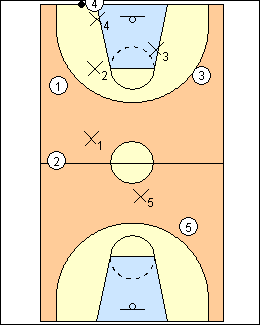 | 1 Bruce Pearl Advantages of the 1-2-1-1 - your team plays more aggressively - wear down the opponent - disrupt the opponent's offence - it's a different style - ability to come from behind - score in bunches - create turnovers in the red zone (near the opponent's basket) - players and fans like it - control tempo - build team chemistry (8 or more play in the regular rotation). X4 beats the inbound passer to the baseline (12 inches off it), gets on the passer's right hand for 1-2 seconds to take away the deep pass, then protects middle. He reads the passer's eyes, yells and distracts him, starts the count for the official, and doesn't jump, the passer may run baseline. Dean Smith - use the 1-2-1-1 (54) on a dead ball or made free throw, X5 is on the ball and X3 on the left (tall players in a trap), with X1 and X2 as interceptors (speed and quickness). On a perimeter pass, try to double-team the receiver, on a gut pass, or once the ball penetrates the hash marks in their backcourt, the press is broken, the defence sprints back, picking up man-to-man. See Defence - Morgan Wootten fullcourt. |
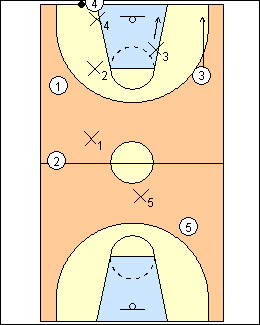 | 2 X2 is the next-quickest defender after X1. He backs up to take the first receiver to the left of the ball, in an intercept position one stride off the passing lane, towards the ball, not denying, forcing towards the corner, seeing man and ball. X3 has the first receiver to the right of the ball, in a denial position, head and hand in the passing lane, staying near the paint (in a position to recover on a ballside inbounds pass), watching for a new receiver to come into his area. Point guard X1 has the next available receiver, he reads the pressure set and reacts, and could be anywhere. X1 gets back to the top of the arc when his team shoots. X5 has the last receiver, he has to cover somebody. He is the best basket protector of the two bigs (build the defence from the basket out), and the most important defender. He sees man and ball (pistols), plays away from his man towards the ball so the receiver can't flash to the ball, and doesn't mind if the receiver goes long. |
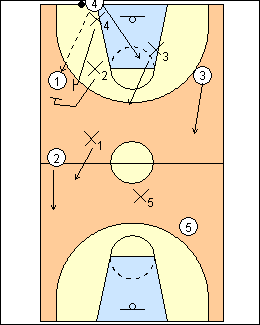 | 3 Immediately trap a ballside inbounds pass, then there are two interceptors and a basket protector. X2 and X4 sprint into the trap with hands up to take away a direct pass, if X2 has a foot out of bounds, a charge will be called on contact. The trappers don't reach, foul with their lower bodies, sprint out of the trap. Interceptors X3 and X1 are guarding three attackers, they read the passer to position themselves. If he is facing upcourt, shoulders parallel to the baseline, X1 favours sideline, X3 middle; if he pivots middle, X1 favours middle and X3 the inbound passer (sometimes they are told not to worry about a pass to 4, but usually they can read and react). X5 looks for a long crosscourt pass, but comes up, they never throw long out of a trap. Don't trap an inbounds pass to the weakside, it's too far for X4 to run, sometimes get into a 2-2-1. If 1 is a good ballhandler, X2 will deny the inbounds pass. If 1 makes the inbounds pass, deny a return pass with the offside wing defender. Dean Smith - if an inbounds pass is made over X2 to 2, X2 can come back to double-team with X1, X5 and X4 would be interceptors, and X3 the goaltender (see Defence - Australia 1-2-1-1, 50 off) |
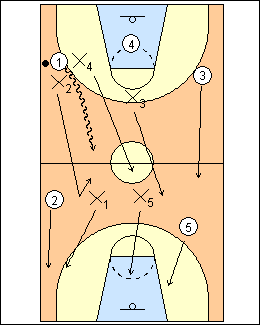 | 4 Transition defence A coaching option is "one and done" (Tom Davis). All defenders recover if the trap is broken by a pass or dribble, usually drop back into man-to-man. X2 sprints to take the ballside wing, X3 sprints to take the opposite wing, X4 and X5 match up with bigs. If 1 splits the trap, X2 sprints to backtip with his inside hand. X1 decides whether X2 takes attacker 2 on the wing and X1 takes the ball, or X1 will take 2 if he is too much of a threat, and X2 takes the ball (shown). Use the same approach if 1 breaks the press with a pass to the middle. On a pass back to 4, optionally X4 leaves the trap to 4, go 1-2-1-1 again. Dean Smith - on a reversal pass to 4, X3 could intercept it if 1 turns his back to make the pass, otherwise move back to a 1-2-1-1 alignment, begin double-teaming if 4 passes to 3. Usually the inbounder is a big not known for his dribbling ability, if the inbounder is a dribbler, X4 could contain him with help from X2 and X3 (double team if he dribbles left or right). |
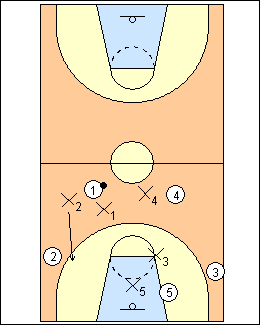 | 5 Here X1 takes the ball, X2 takes 2 on the wing, and will often be in a position to deflect or intercept a pass. X5 stays at the basket. |
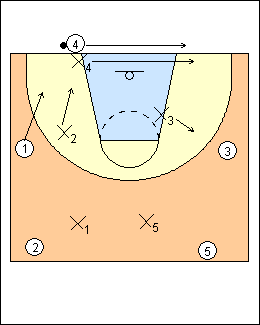 | 6 If 4 runs the baseline, X4 goes with him and takes the outside pass, 4 doesn't want to throw middle. X3 is now ballside and goes from deny to intercept on 3, X2 is now offside and goes from intercept to deny on 1. Defenders will come together and switch if attackers exchange or screen and roll horizontally or vertically. |
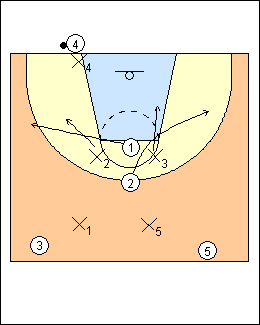 | 7 If two attackers tandem, X2 and X3 don't face guard, they want to see the ball. Usually one attacker will go each way. Variation - face guard the tandem. |
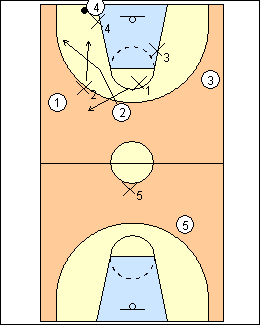 | 8 Pressure sets 3-up X1 does not move up against a 1-up or 2-up pressure set (i.e., two receivers up near the ball), but has to come against a 3-up set. If 2 cuts to the corner, X1 and X2 will switch (2 is now the first receiver to the left of the ball), except if 1 takes X2 deep, then X2 will stay him, and X1 will stay with 2. If 2 breaks up the offside, X3 takes him, X1 takes 3. |
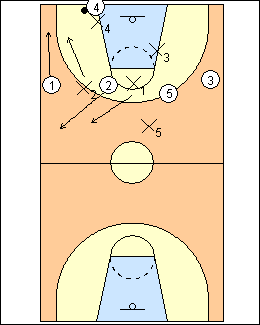 | 9 4-up X2 has the outside, X1 is in the middle, he has two guys to cover, X5 moves up opposite the ball but not all the way, X4 must protect middle, which is vulnerable against a 1-4 set. If 4 runs the baseline, X5 will move opposite. Here 1 breaks to the corner, X2 stays with him, 2 breaks to the ballside sideline, and X1 stays with him. X3 has two receivers. X1 is not matching up man-to-man but asking who is the next available receiver. If he reads that 4 is looking up the middle, X1 may knife to take 5, X5 takes 2, and X3 has 3. |
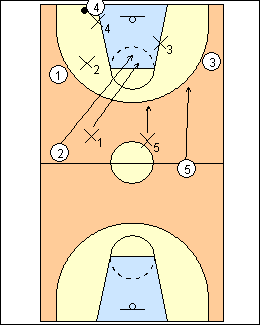 | 10 2-up 2-back 1 matches up if a third attacker comes up towards the ball (next available receiver), then X5 comes if 5 comes up, but X5 stops at the three-point line. |
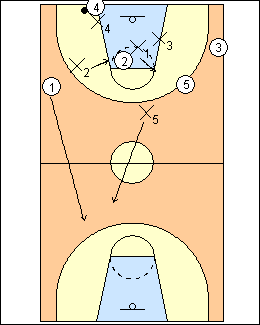 | 11 |
This page was made with Basketball playbook from Jes-Soft
